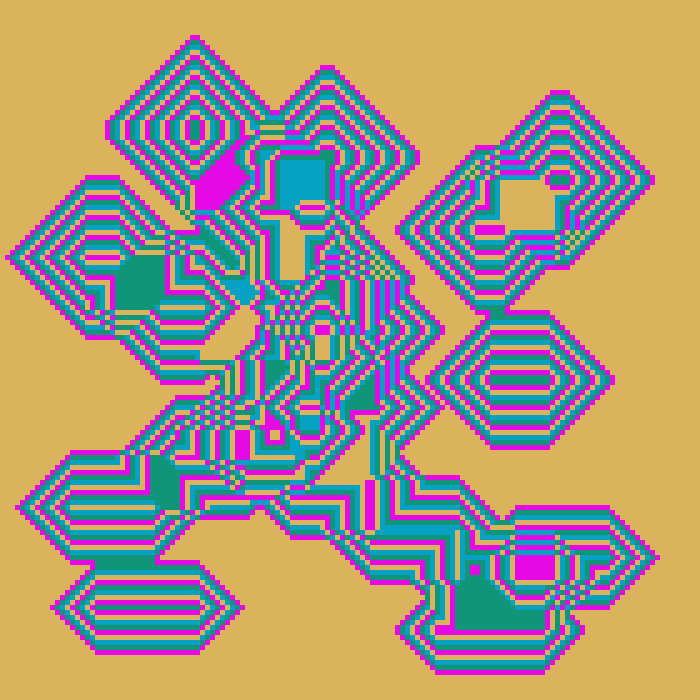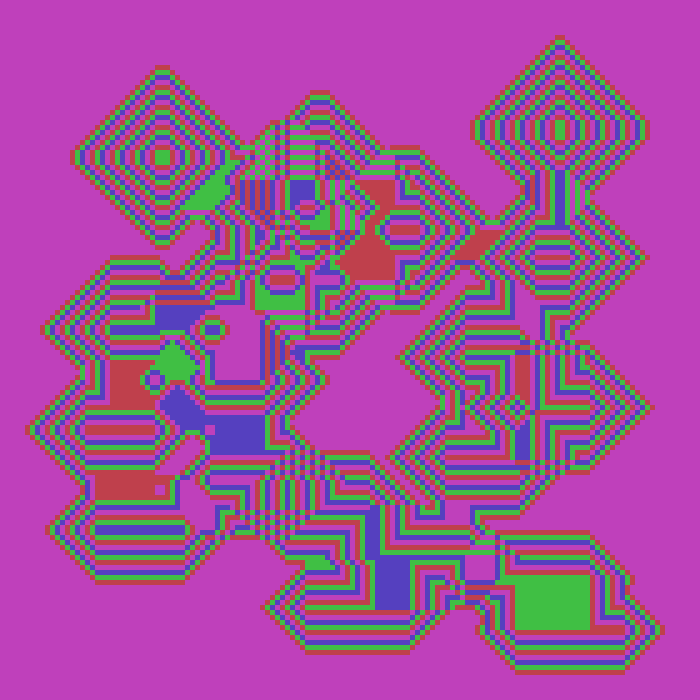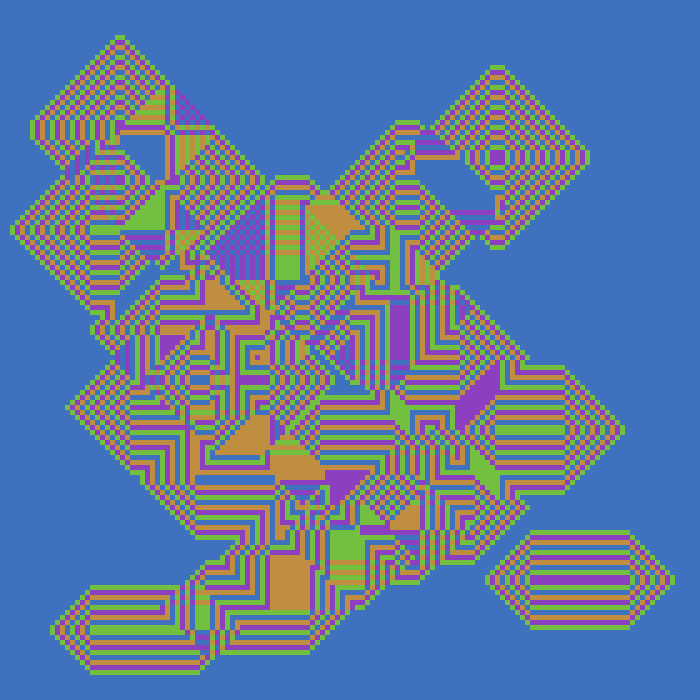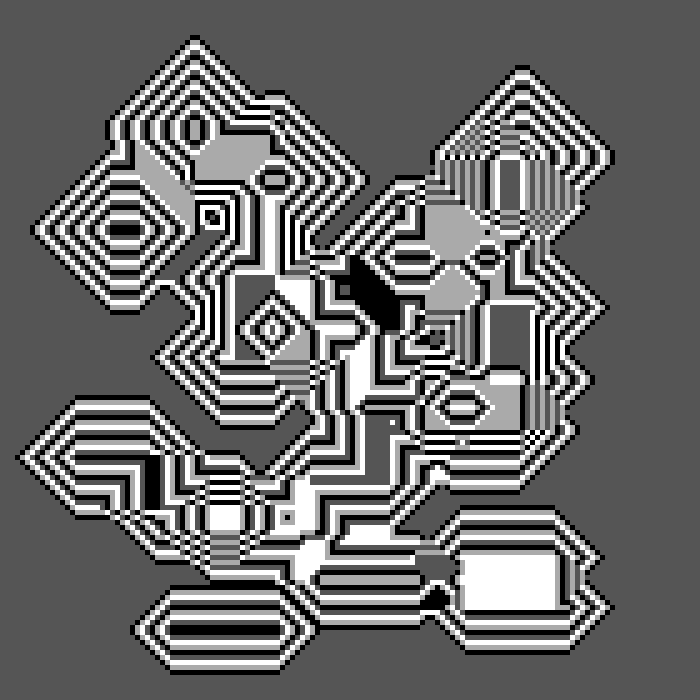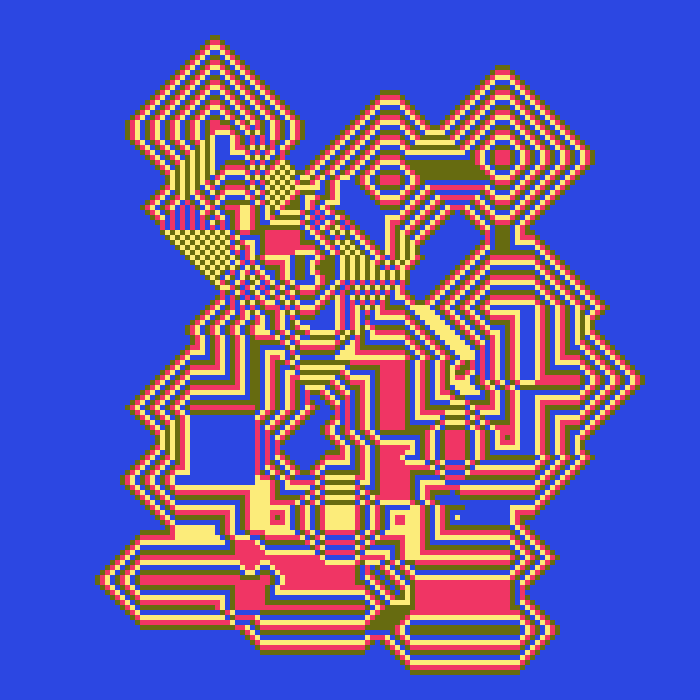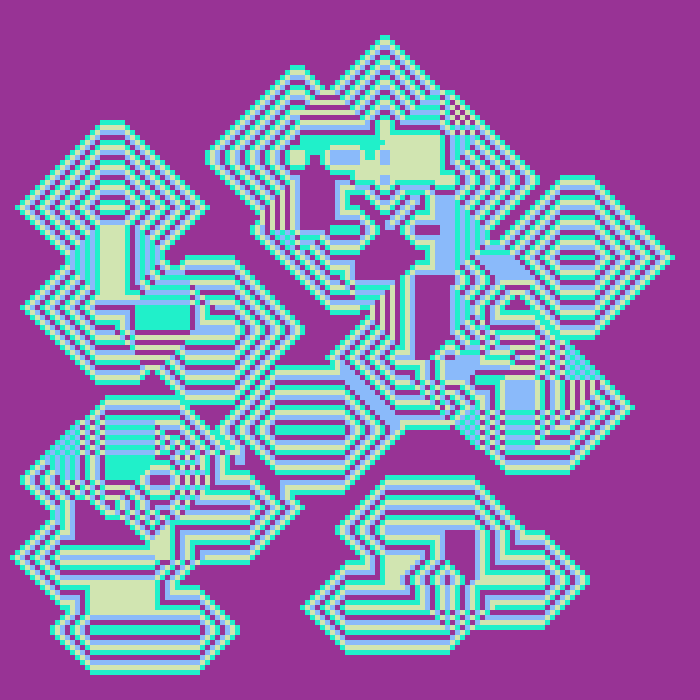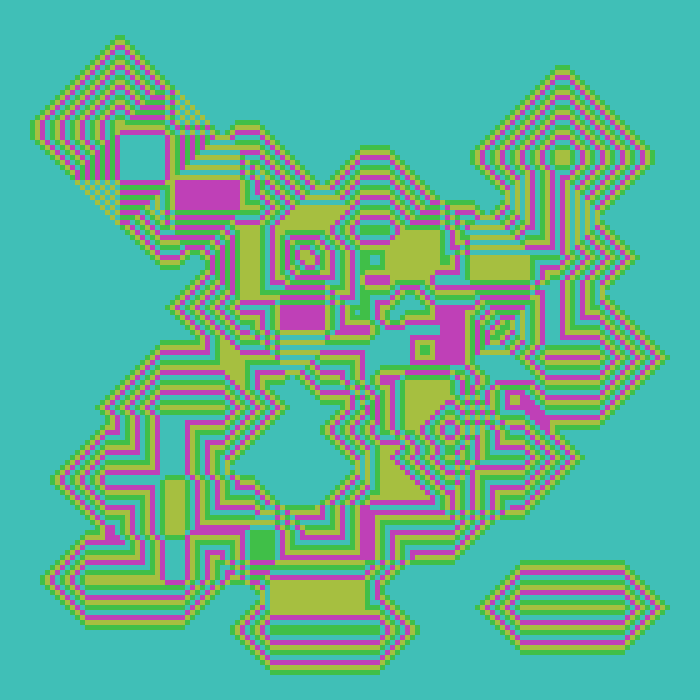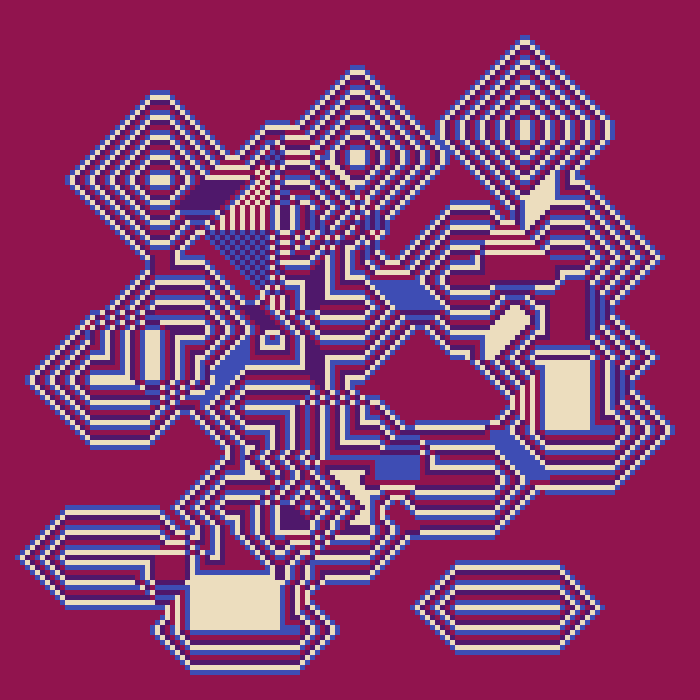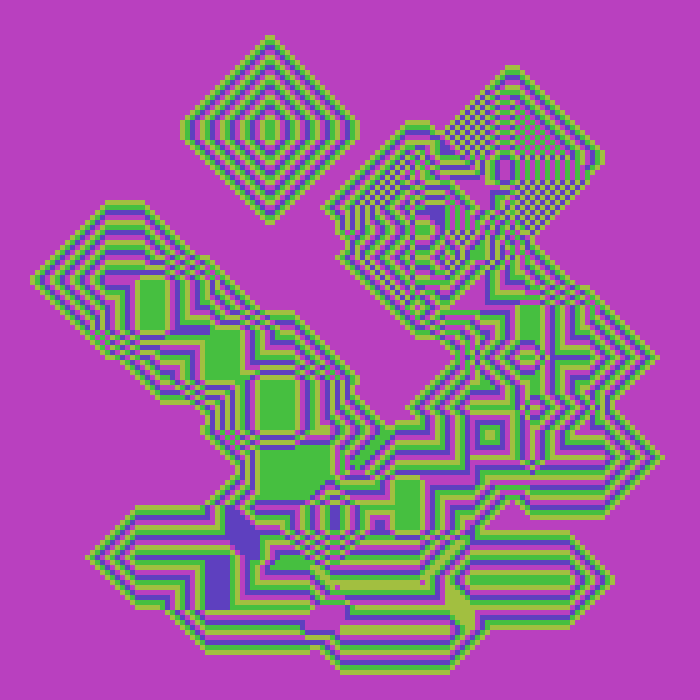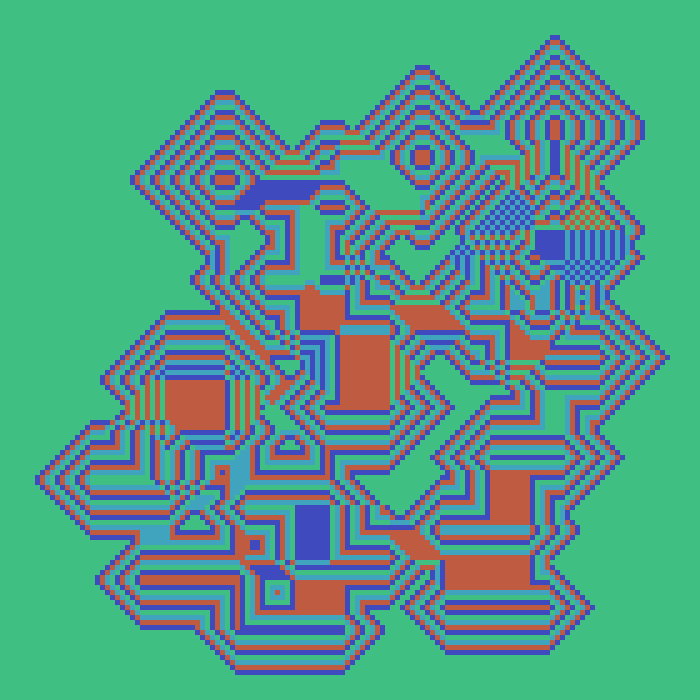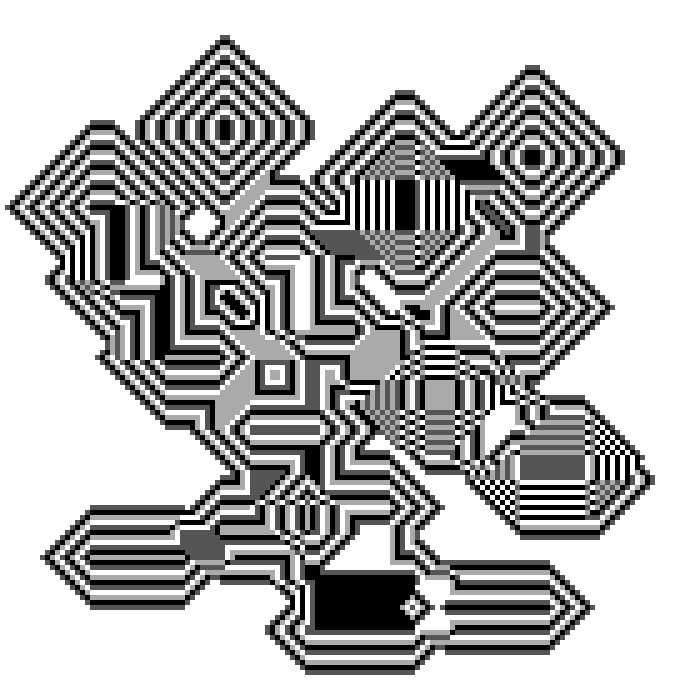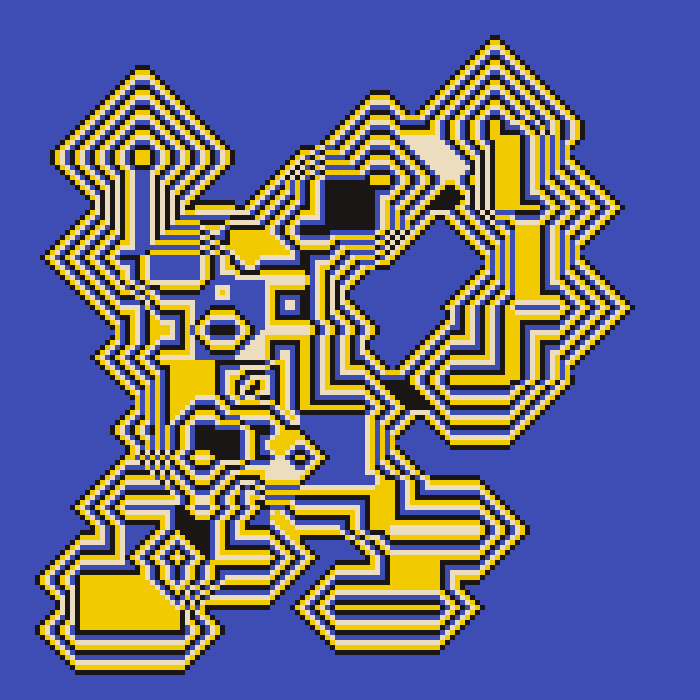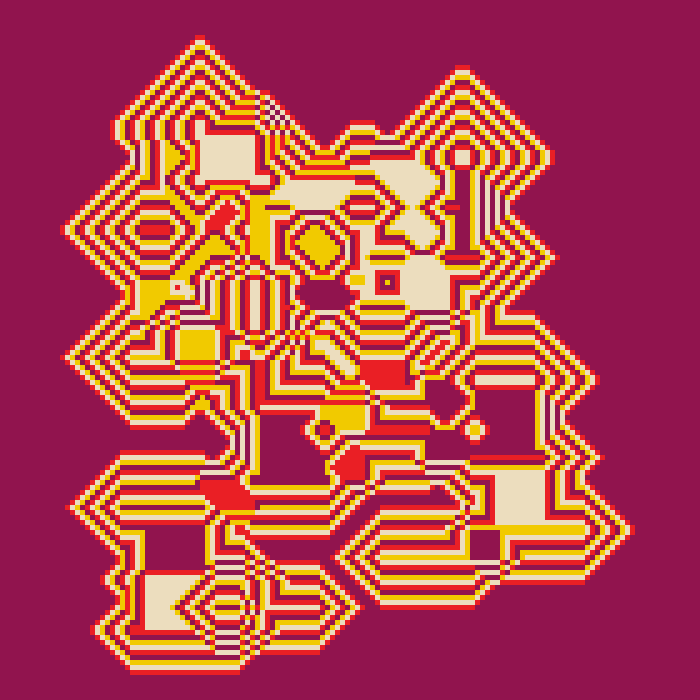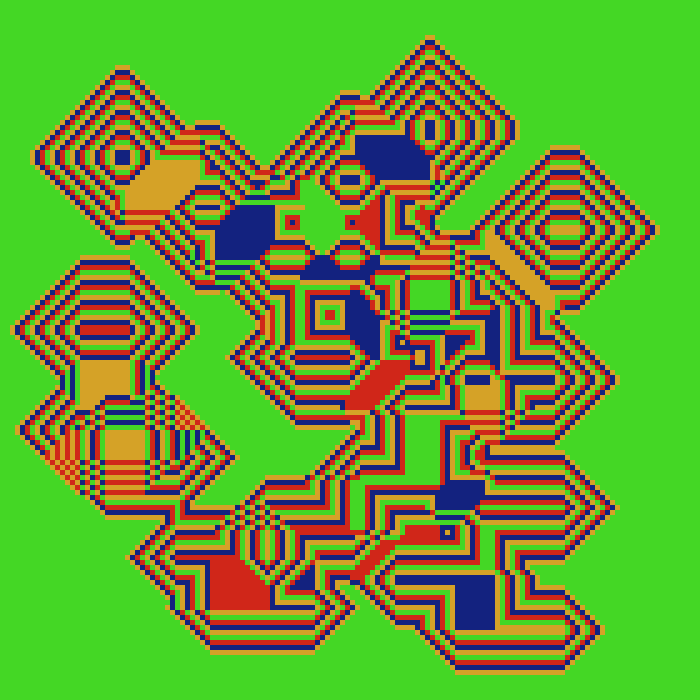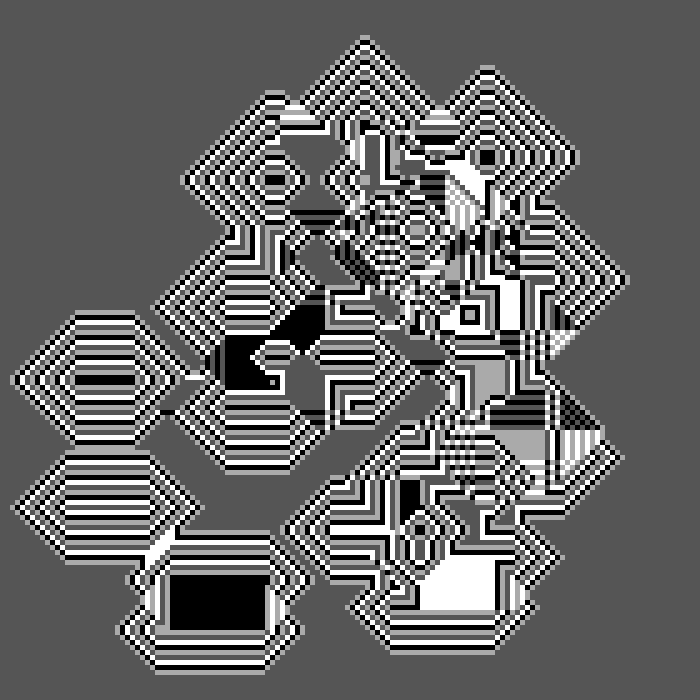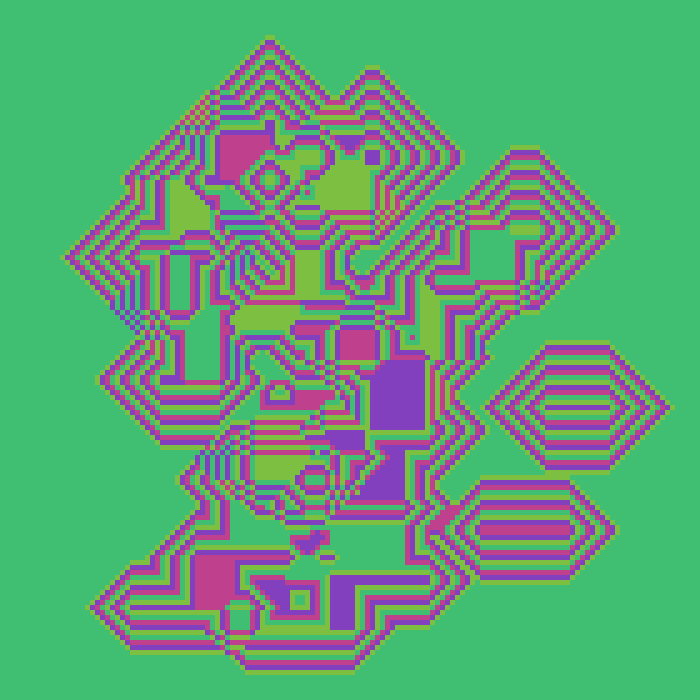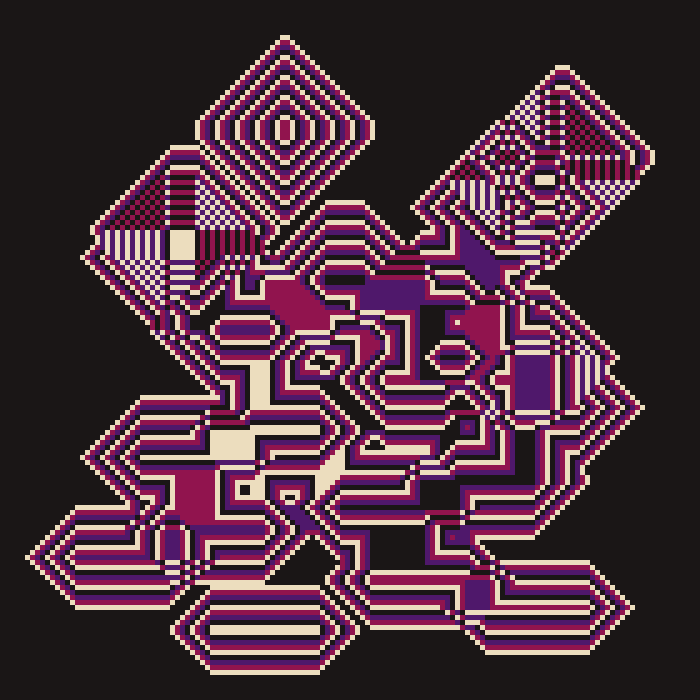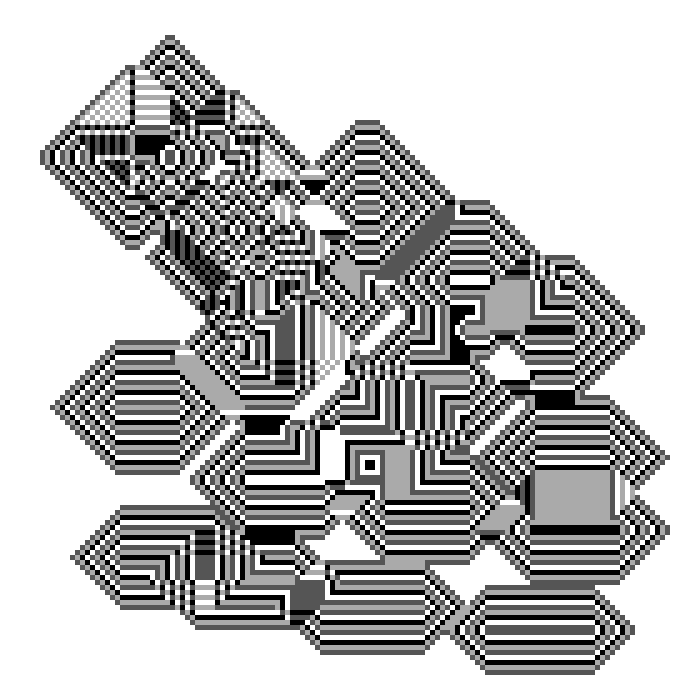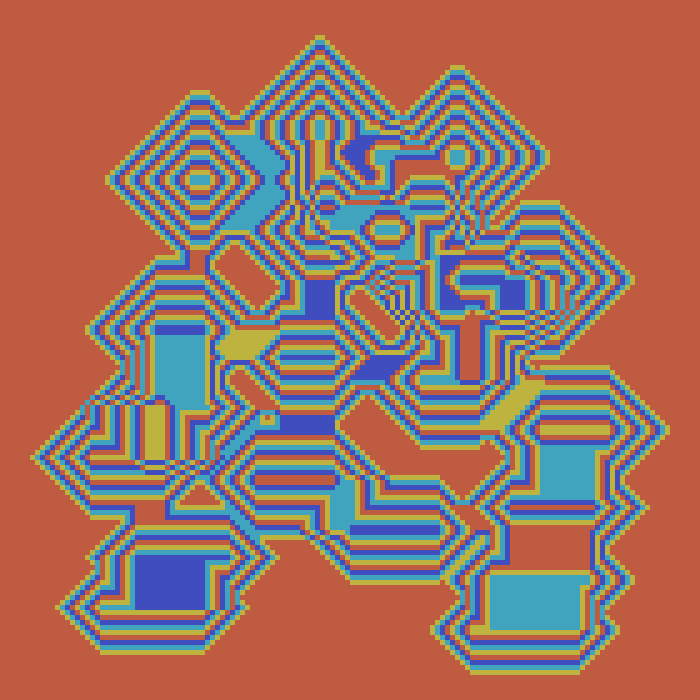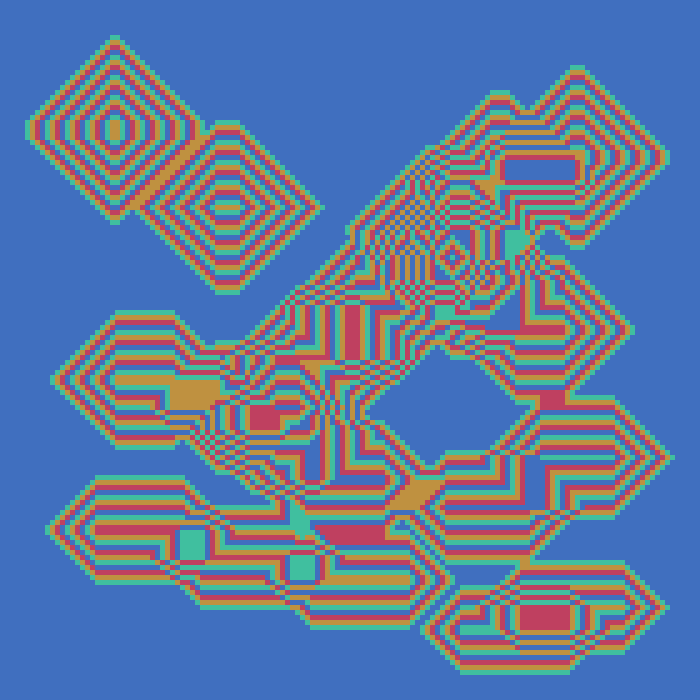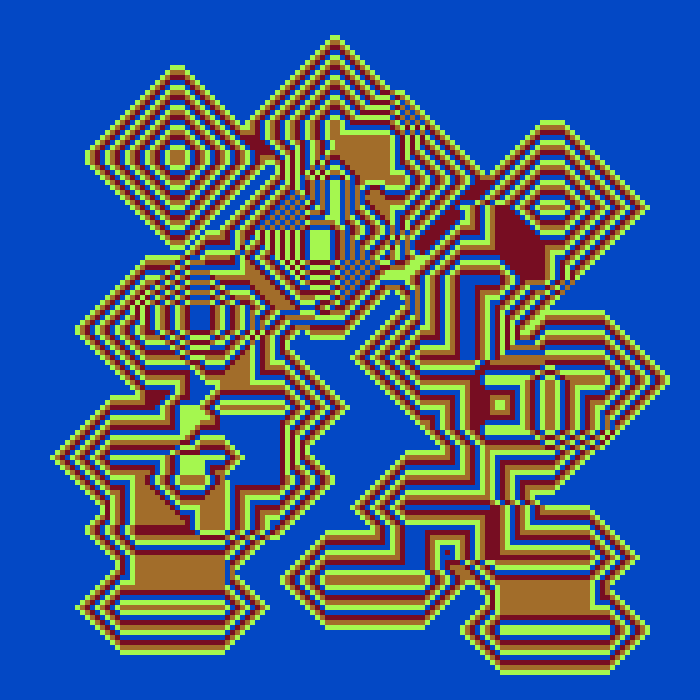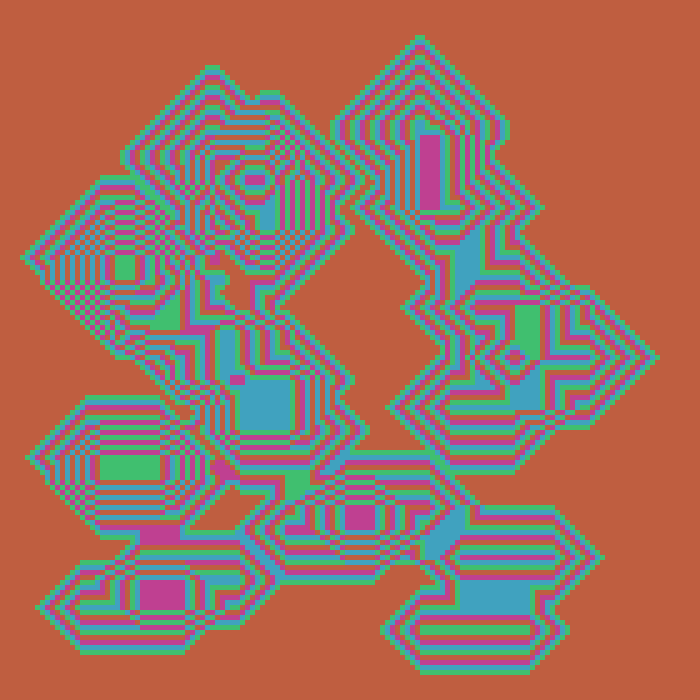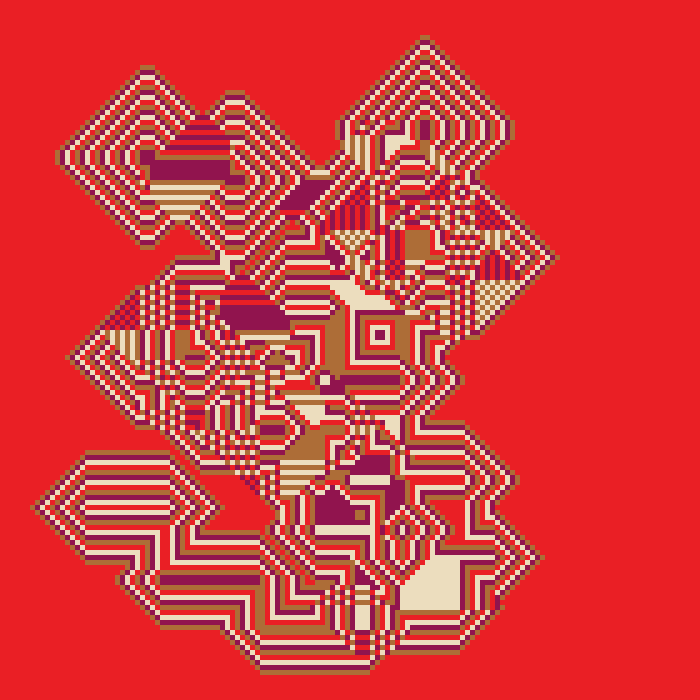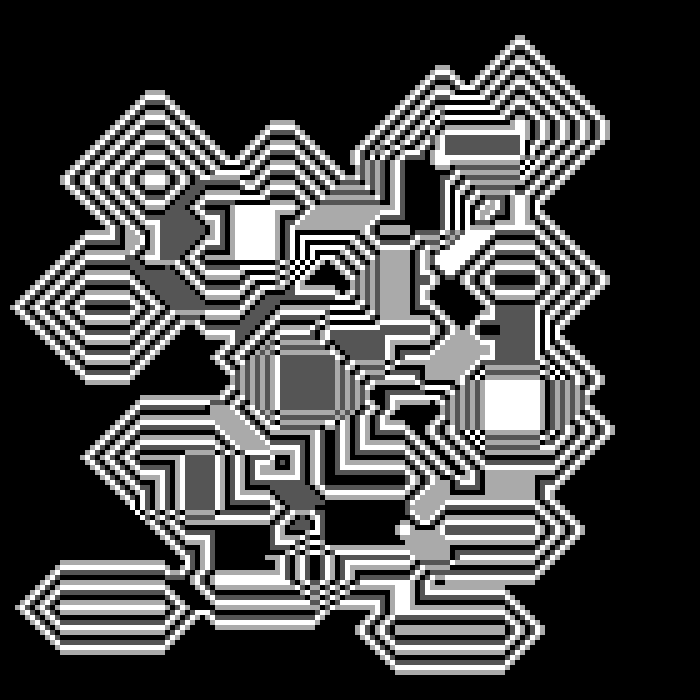Superimposed Octagonal Pyramids
IPFS
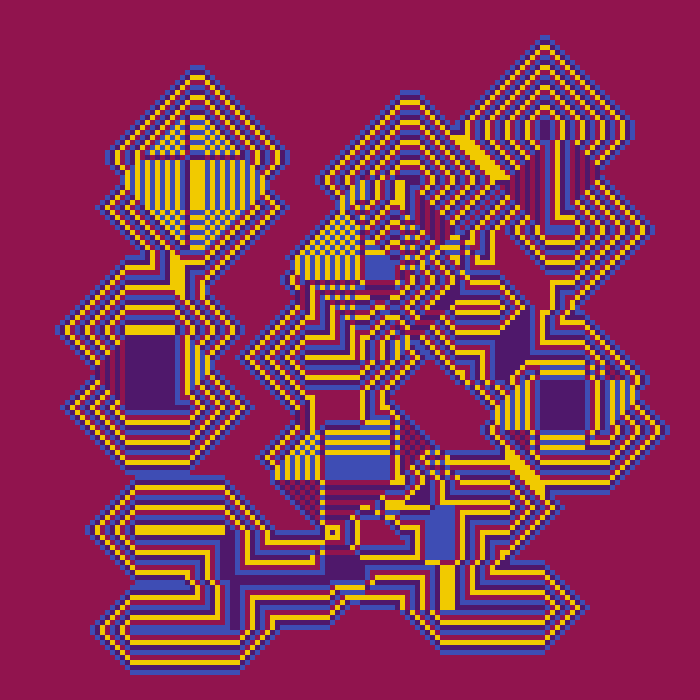
28 July 2022•TEZOS•IPFS
MINI-EXPLOR, Example 3, Contour Plot of Superimposed Octagonal Pyramids
This is the first in series of works where we pay homage to Ken Knowlton, scientist and computer graphic pioneer and artist who passed on June 16, 2022. Ken Knowlton developed the famous EXPLOR language, (Explicit 2-D Patterns, Local Operations, and Randomness) while at Bell Labs. He published a paper describing it in 1975 entitled: MINI-EXPLOR, A FORTRAN-Coded Version of the EXPLOR Language for Mini (and larger) Computers. (https://dl.acm.org/doi/10.1145/988049.988052)
Christopher Scussel and I have collaborated to recreate a faithful translation of MINI-EXPLOR from its original FORTRAN and the limited graphics capabilities of output equipment of the day (c. 1975) to JavaScript that takes advantage of today’s personal computers and their graphical capabilities. This has been a labor of love. Chris worked at Bell Labs for 37 years. I knew Ken as an artist and contributor to a computer art exhibit I curated in 1980. Our intention is to “modernize” the code and use in today’s genre of Generative Art.
In Knowlton’s paper he gave a programmer’s description of MINI-EXPLOR as well as several example to test the described functions and routines. Contour Plot of Superimposed Octagonal Pyramids was one of those examples.
MINI-EXPLOR generated images for output on line printers and early CRT displays. It had a limited palette of 4 “characters” that consisted of configurations of alphanumeric characters, some over-struck, to produce a grayscale. In our representation we have replaced these alphanumeric character configurations with the concept of a “cell” consisting of 5x5 pixel blocks. For now, our picture space is in keeping with the original 140 character limit thus, the image size is 5 x 140 or 700 pixels in height and width.
We present to you the reincarnation of MINI-EXPLOR. We’ve kept the output as faithful as we could to Ken’s original test example. We’ve done three things to modernize the output for this NFT: 1) reformatted the output of the test example to use the full picture space. 2) replaced the original alphanumeric characters that made up a gray scale with blocks of 5x5 pixel “cells” and, 3) we’ve added color. Color EXPLOR images back in 1975 were produced using post-production techniques (printing inks or color gels). However, today full-color capabilities are an inherent part of the media and we use several algorithms to build gray-scale and RGB palettes limited to 4 colors as it was a restriction of the medium in the original design.
We honor the passing of Ken Knowlton with this NFT. Here is an opportunity to collect an example image from the famous program he authored. A true piece of Computer Graphic Art history.
This is the first in series of works where we pay homage to Ken Knowlton, scientist and computer graphic pioneer and artist who passed on June 16, 2022. Ken Knowlton developed the famous EXPLOR language, (Explicit 2-D Patterns, Local Operations, and Randomness) while at Bell Labs. He published a paper describing it in 1975 entitled: MINI-EXPLOR, A FORTRAN-Coded Version of the EXPLOR Language for Mini (and larger) Computers. (https://dl.acm.org/doi/10.1145/988049.988052)
Christopher Scussel and I have collaborated to recreate a faithful translation of MINI-EXPLOR from its original FORTRAN and the limited graphics capabilities of output equipment of the day (c. 1975) to JavaScript that takes advantage of today’s personal computers and their graphical capabilities. This has been a labor of love. Chris worked at Bell Labs for 37 years. I knew Ken as an artist and contributor to a computer art exhibit I curated in 1980. Our intention is to “modernize” the code and use in today’s genre of Generative Art.
In Knowlton’s paper he gave a programmer’s description of MINI-EXPLOR as well as several example to test the described functions and routines. Contour Plot of Superimposed Octagonal Pyramids was one of those examples.
MINI-EXPLOR generated images for output on line printers and early CRT displays. It had a limited palette of 4 “characters” that consisted of configurations of alphanumeric characters, some over-struck, to produce a grayscale. In our representation we have replaced these alphanumeric character configurations with the concept of a “cell” consisting of 5x5 pixel blocks. For now, our picture space is in keeping with the original 140 character limit thus, the image size is 5 x 140 or 700 pixels in height and width.
We present to you the reincarnation of MINI-EXPLOR. We’ve kept the output as faithful as we could to Ken’s original test example. We’ve done three things to modernize the output for this NFT: 1) reformatted the output of the test example to use the full picture space. 2) replaced the original alphanumeric characters that made up a gray scale with blocks of 5x5 pixel “cells” and, 3) we’ve added color. Color EXPLOR images back in 1975 were produced using post-production techniques (printing inks or color gels). However, today full-color capabilities are an inherent part of the media and we use several algorithms to build gray-scale and RGB palettes limited to 4 colors as it was a restriction of the medium in the original design.
We honor the passing of Ken Knowlton with this NFT. Here is an opportunity to collect an example image from the famous program he authored. A true piece of Computer Graphic Art history.
I've been involved in making art with the computer since the early 1970's. I’m one of the few early pioneers who’s still practicing Generative Art today.
128 EDITIONS
•3 RESERVES
minted
125 / 128
fixed price
5 TEZ
Lorem ipsum project longer longer
0.00001 ETH
Lorem ipsum project longer longer
0.00001 ETH
Lorem ipsum project longer longer
0.00001 ETH
Lorem ipsum project longer longer
0.00001 ETH
Lorem ipsum project longer longer
0.00001 ETH
Lorem ipsum project longer longer
0.00001 ETH
Lorem ipsum project longer longer
0.00001 ETH
Lorem ipsum project longer longer
0.00001 ETH
Lorem ipsum project longer longer
0.00001 ETH
Lorem ipsum project longer longer
0.00001 ETH
Lorem ipsum project longer longer
0.00001 ETH
Lorem ipsum project longer longer
0.00001 ETH
Lorem ipsum project longer longer
0.00001 ETH
Lorem ipsum project longer longer
0.00001 ETH
Lorem ipsum project longer longer
0.00001 ETH
Lorem ipsum project longer longer
0.00001 ETH
Lorem ipsum project longer longer
0.00001 ETH
Lorem ipsum project longer longer
0.00001 ETH
Lorem ipsum project longer longer
0.00001 ETH
Lorem ipsum project longer longer
0.00001 ETH
Lorem ipsum project longer longer
0.00001 ETH
Lorem ipsum project longer longer
0.00001 ETH
Lorem ipsum project longer longer
0.00001 ETH
Lorem ipsum project longer longer
0.00001 ETH
